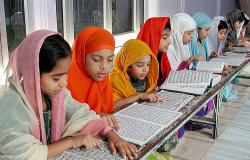Can Education Help Close the Global Gap between Rich and Poor?

Labour markets are undergoing profound transformations. Automation is displacing workers in routine occupations, and as the application of digital technologies and artificial intelligence expand, it will have a similar impact on non-routine jobs (Acemoglu and Restrepo 2016).
Low-skilled workers in high income countries have been under pressure, due to imports from developing countries (Autor et al. 2016). These will also be a shift in the composition of the global pool of skilled workers as young, better-educated cohorts enter the global workforce while older, less-educated cohorts leave. The better-educated workers will come almost exclusively from developing countries, replacing ageing workers from high-income countries in the global pool. In a recent paper (Ahmed et al. 2017), we measure this education wave, driven by developing countries, to attempt to answer these questions:
How does this education wave alter the dynamics of global inequality, both between and within countries? Will these trends lead to further income convergence at the global level? Will inequality within countries also improve?
A look at the past
In The Next Convergence, Spence (2011) makes two important arguments:
After two centuries of divergence (1750 to 1950), during which the ‘western’ rich countries were growing faster than the developing world, we may be living in the middle of a century of convergence (1950 to 2050). The engines of growth are education and integration in the global economy.
In The Great Convergence, Baldwin (2016) also argues that the information and communications technology revolution has helped global income convergence by combining high-tech capital with the best managerial practices and low-paid workers.
Freeman (2007, 2008) takes a shorter time horizon to make the case that the entry into the global economy of workers from China, India and the former Soviet countries at the end of the 1990s has been "the greatest challenge [for the US, and other rich countries] since the Great Depression". He called this process the "great doubling”, because it doubled the size of the global labour market from 1.46 billion to 2.93 billion people. Freeman also argues that, unless high-income countries adjust, this expansion "will exacerbate economic divisions and risk turning much of these countries against globalisation".
Lakner and Milanovic (2015) compare the global distributions of income (or consumption) in 1988 and 2008. Their well-known elephant graph shows growth across the whole population of the world during this period, highlighting that growth since 1988 has greatly benefited the top 1% of the global population – essentially rich people in rich countries – and has boosted incomes for the middle deciles, mostly large, developing countries such as China.
Incomes have stagnated, however, for average citizens of high-income countries, at around the 80th percentile of the global distribution. The same is true for the world's poorest people.
Uneven growth meant that the inequality of the world, as a Gini index calculated as if it were a single country, declined from 69.7 to 65.81 in this period. This decline is largely explained by a drop of inequality between countries or, as Spence and Baldwin observe, by the convergence of developing countries towards advanced-economy per capita incomes.
In contrast, within-country inequality trends have been mixed. In Latin America, inequality within countries has decreased (Lopez-Calva and Lustig 2010) thanks to investment in education, a greater supply of skilled workers, and programmes of targeted transfers. In other regions, prominently among high income countries, inequality within countries has increased.
Between 1988 and 2013, the average of country-specific Gini coefficients in advanced economies increased from 29.8 to 31.8. Overall, the contribution of within-country inequality to total global inequality has risen from 20% in 1988 to 35% in 2013. These domestic ‘economic divisions’ are likely to have contributed to the recent backlash against globalisation, and the anti-trade and nationalist rhetoric of many populist politicians in these countries (Rodrik 2017).
The evolution of education
By investing in education, countries have given younger generations more years of schooling. In 1960, a young worker born in a developing country had spent one more year at school than an older worker.
By 1990, the education gap between the young and the old was three years in South Asia and close to four years in Latin America, the Caribbean and sub-Saharan Africa. In the Middle East and North Africa it was almost six years, more than a full cycle of secondary education. With a few exceptions, the gap increased until 2010.
Figure 1 shows that the pattern of this educational transition is quite different in high-income countries. They started in 1960 with a high inter-generational gap because universal education began earlier. The educational transition had finished by 2010, when young and old workers had almost identical (high) numbers of years of education.
Therefore, average education levels are increasing in developing countries, but not in high-income countries.
Figure 1 Education transition by region, 1960-2010

The total number of skilled workers – defined as those having nine or more years of schooling – will rise from 1.66 billion in 2011 to 2.22 billion by 2050, an increase of 560 million, or 33%. This is not quite another ‘great doubling’, but still a dramatic change.
This pool of skilled workers will be fuelled by younger citizens from developing countries. In 2011, each skilled worker in a high-income country was sharing the global economy with two skilled workers from developing countries. By 2030 the ratio will be one to three.2 This trend will continue until the intergenerational gap in education in developing regions drops to the level of high-income countries.
The future of global inequality
We use a macro-micro simulation framework with more than 100 harmonised household surveys across countries, representing almost 90% of the world population, to estimate the distributional impact of this education wave. Table 1 shows the results. They suggest that a more-educated workforce means the world becomes more equal by 2030. The Gini index for the whole world falls 3.2 percentage points, from 65.8 in 2012 to 62.6 in 2030, while the Theil-L index declines from 90.7 to 76.6.
This continues the trend identified by Lakner and Milanovic. As before, global income inequality decreases because poorer countries are catching up.
Table 1 Global income inequality will decrease in a more educated world

The within-country component of inequality will become even more important in the future. We compare the results of the education wave with a hypothetical 'no-wave scenario' in the right-hand column of Table 1. In the no-wave world, the numbers of both skilled and unskilled workers would grow at the same rate. In the education wave scenario, within countries a decrease in the skill premium drives down inequality. This would not be the case in the no-wave scenario. As a result, total inequality and the within-group component in the no-wave scenario are higher than those in the education wave.
The global growth incidence curves (GICs) for the two scenarios further illustrate who are the greatest beneficiaries of the education wave (Figure 2). The no-wave rates of income expansion are below those of the education wave scenario for everyone with incomes up to about the 90th percentile. This is not a surprise, as the education wave is mainly based in the developing world. To the eye, the distance between these two lines appears small. But a gap of half a percentage point in growth rates accumulates to a 10% higher income after 20 years. This is not a trivial difference.
Figure 2 Global growth incidence curves: Education wave and no-wave scenarios

Does a more educated world imply more equality?
Although education will remain an equaliser in the future, there is an important caveat to our though experiment. The reduction in global inequality assumes that global integration continues.
The gains of international trade are linked to its capacity to create jobs where new opportunities arise. New barriers, and other nationalistic policies, may reduce the tensions created by inequality in the short run, but may also reduce the reduction in inequality in the long run. Technologies that disproportionally increase the demand for skilled workers and replace unskilled workers complicate the debate about how a society should share the burdens and gains from globalisation. The global diffusion of these technologies may reinforce the increasing inequality observed in high-income countries.
Improving the learning outcomes of education, and promoting active redistribution policies, are effective ways of dealing with both globalisation and technological change, while ensuring that the global economy continues on a prosperous path.
Written by
Maurizio Bussolo, Lead Economist, Chief Economist Office for Europe and Central Asia
Delfin S. Go, Consultant, World Bank
This post first appeared on the World Economic Forum's Agenda blog.
Image credit: American Center Mumbai via Flickr


